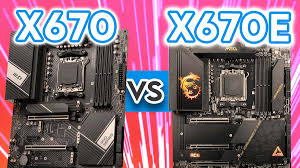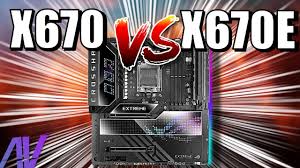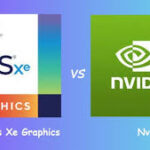Introduction
When diving into the world of motherboards, the options can be overwhelming. Among the top choices for PC enthusiasts are the x670 and x670e. These two heavyweights in the motherboard market are designed to support the latest processors and offer cutting-edge features. But how do you decide which one is right for you? In this article, we’ll break down the differences between x670 and x670e to help you make an informed decision.
What is x670?
Definition and Key Features
The x670 is a high-end motherboard chipset designed for AMD’s Ryzen processors. It’s packed with features that cater to gamers, content creators, and professionals alike. Key features include support for PCIe 4.0, multiple USB 3.2 ports, and robust power delivery systems.
Advantages of Using x670
One of the main advantages of the x670 is its balance of performance and cost. It offers high-end features without the premium price tag of more advanced models. This makes it an excellent choice for users who want strong performance without breaking the bank.
What is x670e?
Definition and Key Features
The x670e, on the other hand, is the elite version of the x670 chipset. The “e” stands for “extreme,” and it lives up to this name by offering even more advanced features. It supports PCIe 5.0, more USB ports, and enhanced overclocking capabilities.
Advantages of Using x670e
With the x670e, users get access to the latest technologies, making it a top choice for those who want the best of the best. It’s designed for extreme performance, supporting higher bandwidth and faster data transfer speeds, which is crucial for high-end gaming and intensive workloads.
Differences Between x670 and x670e
Architecture and Design
The architecture of the x670 and x670e motherboards differs significantly. While both support AMD’s latest processors, the x670e is built with more robust components to handle extreme performance demands. This includes better power phases and cooling solutions.
Performance Capabilities
Performance-wise, the x670e has the edge due to its support for PCIe 5.0, which offers double the bandwidth of PCIe 4.0 found on the x670. This means faster data transfer rates and better overall system responsiveness.
Compatibility with CPUs
Both the x670 and x670e are compatible with AMD’s Ryzen processors. However, the x670e is designed to fully unleash the potential of the latest Ryzen 7000 series, making it a better choice for those planning to use these high-end CPUs.

Performance Comparison
Benchmark Tests
In benchmark tests, the x670e consistently outperforms the x670. The PCIe 5.0 support allows for quicker data processing, which is evident in both synthetic and real-world benchmarks.
Gaming Performance
For gamers, the x670e provides a noticeable boost in frame rates and smoother gameplay, especially in graphics-intensive titles. The faster PCIe lanes also benefit those using the latest graphics cards.
Productivity Performance
In productivity tasks like video editing and 3D rendering, the x670e’s enhanced capabilities shine through. The increased data transfer speeds and better multi-threading support lead to faster rendering times and more efficient workflows.
Compatibility and Connectivity
PCIe Slots
The x670 comes with PCIe 4.0 slots, while the x670e features PCIe 5.0 slots. This difference is crucial for users who need the fastest possible data transfer rates for high-performance graphics cards and SSDs.
USB Ports and Other Connectivity Options
Both motherboards offer ample USB ports, but the x670e typically has more high-speed USB 3.2 Gen 2×2 ports. This means faster data transfer for peripherals and external storage devices.
Expansion Capabilities
Expansion is another area where the x670e excels. It offers more flexibility for adding additional components like additional SSDs or graphics cards, making it a more future-proof option.

Overclocking Potential
Overclocking on x670
The x670 allows for decent overclocking, making it suitable for users who want to push their systems beyond stock performance.
Overclocking on x670e
However, the x670e is built for extreme overclocking. It offers more robust power delivery and better thermal solutions, which means users can achieve higher stable overclocks.
Which is Better for Overclocking?
For enthusiasts looking to squeeze every bit of performance from their CPUs, the x670e is the clear winner.
Price and Value for Money
Price Comparison
The x670e comes at a premium price compared to the x670. This is due to its advanced features and better performance capabilities.
Value Proposition of x670
Despite being less expensive, the x670 offers great value for users who don’t need the absolute latest technology. It provides excellent performance for its price point.
Value Proposition of x670e
The x670e, while more expensive, offers the best performance and features available. For users who need cutting-edge technology and are willing to pay for it, the x670e is worth the investment.
Must Read: Scaling Mode Override
User Reviews and Feedback
Common Praises and Complaints for x670
Users often praise the x670 for its solid performance and value. However, some complaints include its lack of PCIe 5.0 support and fewer high-speed USB ports compared to the x670e.
Common Praises and Complaints for x670e
The x670e receives high marks for its performance and feature set. However, its higher price point is a common complaint among users who might not need its extreme capabilities.

Which One Should You Choose?
Best for Gamers
Gamers who want the best performance and are using the latest graphics cards should opt for the x670e.
Best for Content Creators
Content creators will benefit from the faster data transfer rates and better multi-threading support of the x670e.
Best for General Users
For general users or those on a budget, the x670 provides excellent performance at a more affordable price.
Future Proofing
How Future-Proof is x670?
The x670 is reasonably future-proof with its support for current technologies and robust performance capabilities.
How Future-Proof is x670e?
The x670e, with its support for PCIe 5.0 and other cutting-edge features, is more future-proof and will handle upcoming technologies better.
Installation and Setup
Ease of Installation for x670
The x670 is relatively straightforward to install, with ample documentation and community support.
Ease of Installation for x670e
The x670e, while slightly more complex due to its advanced features, is still user-friendly for those with some experience.
Technical Support and Warranty
Support Options for x670
Most x670 motherboards come with solid technical support and warranty options, ensuring peace of mind for users.
Support Options for x670e
Similarly, x670e motherboards offer robust support and warranty, reflecting their premium status.
Environmental Impact
Energy Efficiency of x670
The x670 is designed with energy efficiency in mind, making it a good choice for eco-conscious users.
Energy Efficiency of x670e
The x670e, despite its higher performance, also offers excellent energy efficiency thanks to advanced power management features.
Must Read: JBL EON 610
Conclusion
Both the x670 and x670e are excellent choices for different types of users. If you need cutting-edge performance and future-proofing, the x670e is worth the investment. However, if you’re looking for great performance without the premium price, the x670 is a fantastic option.
FAQs
Can I use a Ryzen 7000 series CPU with the x670 motherboard?
Yes, the x670 supports Ryzen 7000 series CPUs, though it pairs even better with the x670e for maximum performance.
Is the x670e worth the extra cost?
For users needing the best performance and future-proofing, the x670e is worth the investment. For others, the x670 may suffice.
Do both motherboards support PCIe 5.0?
Only the x670e supports PCIe 5.0, while the x670 supports PCIe 4.0.
Which motherboard is better for overclocking?
The x670e is better suited for overclocking due to its enhanced power delivery and cooling solutions.
Are there significant differences in gaming performance between the two?
Yes, the x670e generally offers better gaming performance, especially with the latest graphics cards and games.









